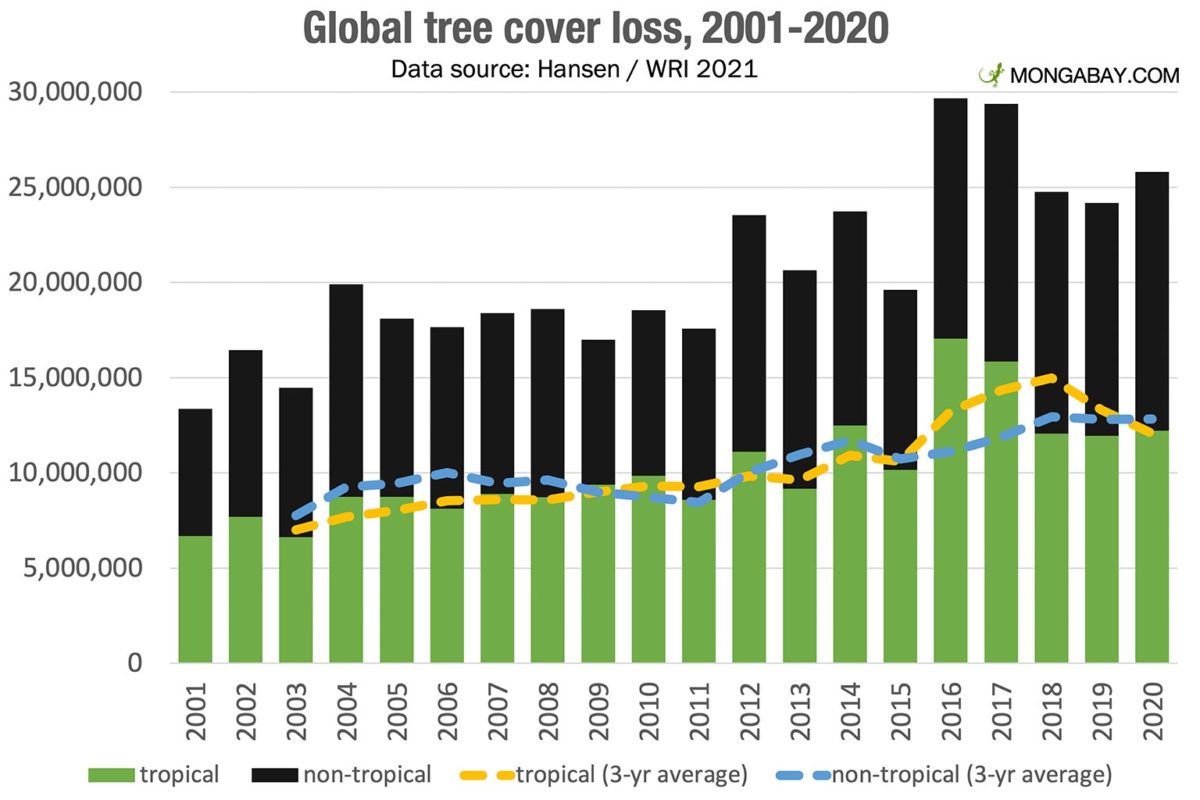Wildfires Drive Record Global Forest Loss: A Critical Analysis

Table of Contents
The Rising Threat of Wildfires and Climate Change
Increased Frequency and Intensity
Wildfires are becoming more frequent and intense due to rising global temperatures, prolonged droughts, and changes in precipitation patterns. Climate change is significantly altering fire regimes worldwide, leading to longer and more severe fire seasons.
- Increased aridity: Higher temperatures and reduced rainfall create drier conditions, turning forests into tinderboxes.
- Longer fire seasons: Warmer springs and autumns extend the period when wildfires can ignite and spread rapidly.
- Stronger winds fueling rapid fire spread: Climate change can also influence wind patterns, increasing the speed and intensity of wildfires, making them harder to contain.
Scientific studies, such as those published in Nature and Science, clearly link the increasing severity and frequency of wildfires to anthropogenic climate change. These studies demonstrate a strong correlation between rising temperatures, drought conditions, and the extent and intensity of wildfires globally.
Feedback Loops and Carbon Emissions
Wildfires release massive amounts of carbon dioxide (CO2) into the atmosphere, exacerbating climate change and creating a dangerous feedback loop. Burning forests, which act as vital carbon sinks, release stored carbon, contributing significantly to global greenhouse gas emissions.
- Loss of carbon sinks: Forests absorb CO2 from the atmosphere; their destruction diminishes this crucial carbon sequestration capacity.
- Increased greenhouse gas emissions: Wildfires are a major source of greenhouse gas emissions, including CO2, methane, and black carbon, further accelerating global warming.
- Contribution to global warming: The additional CO2 released intensifies the greenhouse effect, leading to higher temperatures and creating a vicious cycle that fuels more intense wildfires.
The 2019-2020 Australian bushfires, for example, released an estimated one billion tonnes of CO2 into the atmosphere – a stark illustration of the devastating contribution of wildfires to climate change.
Deforestation and its Contribution to Wildfire Risk
Human-Induced Deforestation
Clearing forests for agriculture, logging, and urban development creates drier landscapes, significantly increasing wildfire susceptibility. The removal of trees and vegetation leaves behind large amounts of flammable material, increasing fuel loads and creating conditions ripe for ignition.
- Fragmentation of forests: Smaller, isolated forest patches are more vulnerable to wildfires than larger, continuous forests.
- Removal of natural firebreaks: Forests naturally contain firebreaks, such as rivers and clearings; deforestation eliminates these barriers.
- Increased fuel loads: The accumulation of dry underbrush and debris in deforested areas provides ample fuel for wildfires to spread rapidly.
The conversion of forests to agricultural land, particularly in tropical regions, is a major driver of deforestation and increases the risk of large-scale wildfires.
Unsustainable Forestry Practices
Poor forest management practices, such as inadequate fuel management and a lack of controlled burns, increase the risk and severity of wildfires. The accumulation of dry underbrush and debris creates a high fire hazard, while ineffective fire suppression strategies can allow small fires to escalate into large, devastating blazes.
- Accumulation of dry underbrush: Failure to remove flammable undergrowth creates a significant fire risk.
- Lack of preventative measures: Insufficient investment in forest management and fire prevention increases vulnerability.
- Ineffective fire suppression strategies: Outdated equipment, inadequate training, and insufficient resources hinder effective wildfire control.
Implementing sustainable forestry practices, including controlled burns and fuel reduction measures, is crucial for mitigating wildfire risk.
The Socioeconomic Consequences of Global Forest Loss
Economic Impacts
Wildfires cause significant economic damage through property destruction, loss of timber resources, and disruption of tourism. The costs associated with firefighting, infrastructure repair, and economic recovery can be staggering.
- Cost of firefighting: Suppression efforts require significant financial resources, often straining local and national budgets.
- Damage to infrastructure: Wildfires can destroy homes, businesses, roads, and power lines, leading to extensive repair costs.
- Loss of livelihoods: Wildfires can devastate industries reliant on forests, such as timber production and tourism.
- Decreased property values: The risk of future wildfires can significantly decrease property values in affected areas.
The economic impact of major wildfires can run into billions of dollars, imposing a heavy burden on affected communities and economies.
Social Impacts
Wildfires displace communities, disrupt livelihoods, and pose significant health risks due to smoke inhalation and air pollution. The psychological trauma experienced by those affected can also have long-lasting consequences.
- Loss of homes and displacement: Wildfires can force people to evacuate their homes, leading to displacement and homelessness.
- Health problems: Smoke inhalation can cause respiratory illnesses and other health problems, particularly for vulnerable populations.
- Psychological trauma: The loss of homes, loved ones, and livelihoods can lead to significant psychological distress.
- Impact on indigenous communities: Indigenous communities, who often have deep cultural and spiritual ties to forests, are disproportionately affected by wildfires.
The social cost of wildfires extends far beyond the immediate impact, affecting communities for years to come.
Conclusion
Record global forest loss driven by increasingly severe wildfires poses a critical threat to the environment, economy, and human well-being. Climate change, deforestation, and unsustainable forestry practices are key contributing factors. The consequences are far-reaching, impacting ecosystems, economies, and communities worldwide. The frequency and intensity of wildfires are expected to continue increasing, highlighting the urgency of addressing this multifaceted challenge.
Addressing the issue of global forest loss requires urgent and concerted action. We need to implement sustainable forest management practices, combat deforestation, mitigate climate change through reducing greenhouse gas emissions, and invest in advanced wildfire prevention and suppression technologies. Let's work together to protect our forests and prevent future records of devastating wildfires and global forest loss. The future of our planet depends on it.

Featured Posts
-
 Atletico Madrid Hasret Sonunda Bitiyor
May 26, 2025
Atletico Madrid Hasret Sonunda Bitiyor
May 26, 2025 -
 Nonton Live Streaming Sprint Race Moto Gp Inggris Jam 20 00 Wib
May 26, 2025
Nonton Live Streaming Sprint Race Moto Gp Inggris Jam 20 00 Wib
May 26, 2025 -
 Paris Roubaix 2024 Van Der Poel Finishes Third Pogacar Distant
May 26, 2025
Paris Roubaix 2024 Van Der Poel Finishes Third Pogacar Distant
May 26, 2025 -
 The China Us Trade Truce How Exporters Are Responding
May 26, 2025
The China Us Trade Truce How Exporters Are Responding
May 26, 2025 -
 Is Buy And Hold Investing Worth The Long Game A Realistic Look
May 26, 2025
Is Buy And Hold Investing Worth The Long Game A Realistic Look
May 26, 2025
Latest Posts
-
 No Credit Check Loans Direct Lender Understanding Guaranteed Approval
May 28, 2025
No Credit Check Loans Direct Lender Understanding Guaranteed Approval
May 28, 2025 -
 Rayan Cherki To Manchester United Latest Transfer Developments
May 28, 2025
Rayan Cherki To Manchester United Latest Transfer Developments
May 28, 2025 -
 Guaranteed Approval Loans No Credit Check Needed Direct Lender Options
May 28, 2025
Guaranteed Approval Loans No Credit Check Needed Direct Lender Options
May 28, 2025 -
 Manchester United Eyeing Rayan Cherki Transfer News And Analysis
May 28, 2025
Manchester United Eyeing Rayan Cherki Transfer News And Analysis
May 28, 2025 -
 Newsflash German Update On Young Star Rayan Cherki
May 28, 2025
Newsflash German Update On Young Star Rayan Cherki
May 28, 2025
